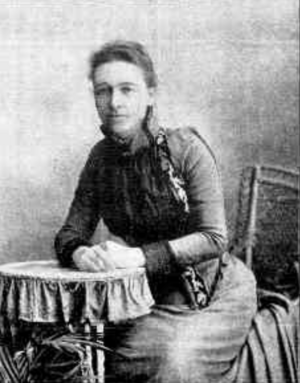Maybanke Anderson facts for kids
Maybanke Susannah Anderson (born Selfe, and also known as Maybanke Wolstenholme) was an important Australian who worked for big changes in society. She helped women get the right to vote and played a part in Australia becoming a united country. She was born on February 16, 1845, and passed away on April 15, 1927.
Contents
Early Life and Family
Maybanke Selfe was born in Kingston upon Thames, England, near London. Her father, Henry Selfe, was a plumber. Her family moved to Australia in January 1855 when she was nine years old.
In September 1867, Maybanke married Edmund Kay Wolstenholme, who worked with timber. They had seven children. Sadly, four of their children died young from a heart condition. Their son, Harry Wolstenholme, grew up to be a lawyer and loved studying birds. The family lived in a large house called 'Maybanke' in Marrickville.
Maybanke's marriage became difficult. Edmund left the family in 1884. Maybanke had to wait until a new law was passed in 1892 to get a divorce. Her divorce was final in 1893. After this, her brother, Norman Selfe, who was a famous engineer, helped her financially. They later worked together to improve education.
Champion for Women's Rights
After her divorce, Maybanke became very active in helping women and children. She strongly believed that women should have the right to vote. She felt that getting the vote was the key to making many other good changes in society.
She became a leader in the women's suffrage movement. "Suffrage" means the right to vote. She was a vice president of the Women's Literary Society. Many members of this group later formed the Womanhood Suffrage League of New South Wales (WSL) in 1891. In 1893, Maybanke became the president of the WSL. That same year, she started the Australasian Home Reading Union. This group helped people in country areas form small study groups to learn more.
In 1894, Maybanke started her own newspaper called Woman's Voice. It came out every two weeks for 18 months. The paper told women about voting issues happening in Australia and around the world. In 1895, she helped open Australia's first free kindergarten in Woolloomooloo. This helped children whose mothers worked.
The WSL tried hard to get the government in New South Wales to give women the vote, but it was difficult. In 1897, Maybanke decided to ask the Federal Convention in Adelaide for help. She believed that if women's voting rights were part of the plan for a united Australia, it would be harder to take away. This would protect the voting rights of women in South Australia and Western Australia, who already had them. She also thought that if women could vote at the national level, it would eventually lead to them voting in all the states.
Maybanke also became involved in the movement to unite the Australian colonies into one country, known as Federation. She left the WSL in 1897. Finally, women in New South Wales gained the right to vote in 1902.
In 2001, Maybanke was added to the Victorian Honour Roll of Women. This was to celebrate her many achievements.
Later Life and Travels
In 1899, Maybanke married her second husband, Sir Francis Anderson. He was the first Professor of Philosophy at the University of Sydney. They traveled and worked together on many projects. They campaigned for women to be able to run for local government positions. Maybanke was also active with the National Council of Women of New South Wales. She worked closely with the University Women's Society. Maybanke passed away in Paris, France, on April 15, 1927.
Images for kids
-
Maybanke Kindergarten in Pyrmont, New South Wales, named after Anderson
See also
 In Spanish: Maybanke Anderson para niños
In Spanish: Maybanke Anderson para niños



